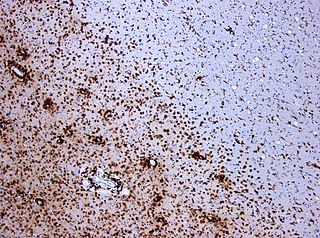Related Research Articles

Multiple sclerosis (MS) is an autoimmune disease in which the insulating covers of nerve cells in the brain and spinal cord are damaged. This damage disrupts the ability of parts of the nervous system to transmit signals, resulting in a range of signs and symptoms, including physical, mental, and sometimes psychiatric problems. Specific symptoms can include double vision, vision loss, eye pain, muscle weakness, and loss of sensation or coordination. MS takes several forms, with new symptoms either occurring in isolated attacks or building up over time. In the relapsing forms of MS, between attacks, symptoms may disappear completely, although some permanent neurological problems often remain, especially as the disease advances. In the progressive forms of MS, bodily function slowly deteriorates and disability worsens once symptoms manifest and will steadily continue to do so if the disease is left untreated.

Interferon beta-1a is a cytokine in the interferon family used to treat multiple sclerosis (MS). It is produced by mammalian cells, while interferon beta-1b is produced in modified E. coli. Some research indicates that interferon injections may result in an 18–38% reduction in the rate of MS relapses.
The Multiple Sclerosis Society is the UK's largest charity for people affected by multiple sclerosis (MS). Based in London, it has offices and local groups in England, Northern Ireland, Scotland and Wales. It gained charitable company status in 2010.
The National Multiple Sclerosis Society (NMSS) is a nonprofit organization founded in 1946. It is an organization dedicated to supporting individuals affected by multiple sclerosis (MS) and funding research to find a cure for the disease. They provide resources, support services, advocacy efforts, and educational programs to improve the lives of people with MS and their families.

The Multiple Sclerosis International Federation (MSIF) was established in 1967 as an international body linking the activities of various national MS societies. The federation seeks to partner with member societies and the international scientific community to eliminate multiple sclerosis and its consequences, and to advocate for those affected by multiple sclerosis.
The Swank Diet is a diet that is low in saturated fat, which was proposed in 1949 by Roy Laver Swank, MD, PhD (1909–2008), academic neurologist at the University of Oregon, for the treatment of multiple sclerosis.
Multiple sclerosis (MS) is a chronic inflammatory demyelinating disease that affects the central nervous system (CNS). Several therapies for it exist, although there is no known cure.
Inflammatory demyelinating diseases (IDDs), sometimes called Idiopathic (IIDDs) due to the unknown etiology of some of them, are a heterogenous group of demyelinating diseases - conditions that cause damage to myelin, the protective sheath of nerve fibers - that occur against the background of an acute or chronic inflammatory process. IDDs share characteristics with and are often grouped together under Multiple Sclerosis. They are sometimes considered different diseases from Multiple Sclerosis, but considered by others to form a spectrum differing only in terms of chronicity, severity, and clinical course.

Marburg acute multiple sclerosis, also known as Marburg multiple sclerosis or acute fulminant multiple sclerosis, is considered one of the multiple sclerosis borderline diseases, which is a collection of diseases classified by some as MS variants and by others as different diseases. Other diseases in this group are neuromyelitis optica (NMO), Balo concentric sclerosis, and Schilder's disease. The graver course is one form of malignant multiple sclerosis, with patients reaching a significant level of disability in less than five years from their first symptoms, often in a matter of months.
Research in multiple sclerosis may find new pathways to interact with the disease, improve function, curtail attacks, or limit the progression of the underlying disease. Many treatments already in clinical trials involve drugs that are used in other diseases or medications that have not been designed specifically for multiple sclerosis. There are also trials involving the combination of drugs that are already in use for multiple sclerosis. Finally, there are also many basic investigations that try to understand better the disease and in the future may help to find new treatments.
MS Focus: The Multiple Sclerosis Foundation, also known as the Multiple Sclerosis Foundation or just MS Focus, is a 501(c)(3) non-profit organization benefiting people with multiple sclerosis and their families. It was established in 1986, and is headquartered in Fort Lauderdale, Florida.
Fred D. Lublin is an American neurologist and an authority on the treatment of multiple sclerosis. Along with colleagues at the National Multiple Sclerosis Society, his work redefined the clinical course definitions of MS.

Chronic cerebrospinal venous insufficiency is a term invented by Italian researcher Paolo Zamboni in 2008 to describe compromised flow of blood in the veins draining the central nervous system. Zamboni hypothesized that it might play a role in the cause or development of multiple sclerosis (MS). Zamboni also devised a surgical procedure which the media nicknamed a liberation procedure or liberation therapy, involving venoplasty or stenting of certain veins. Zamboni's ideas about CCSVI are very controversial, with significantly more detractors than supporters, and any treatments based on his ideas are considered experimental.

Current standards for diagnosing multiple sclerosis (MS) are based on the 2018 revision of McDonald criteria. They rely on MRI detection of demyelinating lesions in the CNS, which are distributed in space (DIS) and in time (DIT). It is also a requirement that any possible known disease that produces demyelinating lesions is ruled out before applying McDonald's criteria.

Stephen L. Hauser is a professor of the Department of Neurology at the University of California, San Francisco (UCSF) specializing in immune mechanisms and multiple sclerosis (MS). He has contributed to the establishment of consortia that have identified more than 50 gene variants that contribute to MS risk.
Lorna Jean Moorhead is an American author, health columnist and health advocate. She is one of the first writers on the subject of women's health issues pertaining to multiple sclerosis.

John Francis Kurtzke was a neuroepidemiologist and Professor of Neurology at Georgetown University who is best known for his creation of the Expanded Disability Status Scale and for his research on multiple sclerosis (MS). After graduating from Cornell University Medical College in 1952, Dr. Kurtzke started his career in the field of Neurology as Chief of the Neurology Service at the Veteran's Affairs (VA) Medical Centers in Coatesville, Pennsylvania, from 1956 to 1963, and then in Washington, DC, from 1963 to 1995, where he became Professor of Neurology at Georgetown University. At the time of his death, he held the title of Professor Emeritus at Georgetown University.
Harry M. Weaver was an American neuroscientist and researcher who made contributions to medical research in the fields of Multiple sclerosis, and was the Director of Research at the National Foundation for Infantile Paralysis when the Polio vaccine was discovered and developed by Jonas Salk. Dr. Weaver also served as the Vice President for Research at the American Cancer Society, Vice President for Research and Development at the Schering Corporation, and as the Director of Research at the National Multiple Sclerosis Society.
Alan J. Thompson, MD, FMedSci, FRCP, FRCPI, is Dean of the Faculty of Brain Sciences at UCL; Pro-Provost for London at UCL; Garfield Weston Professor of Clinical Neurology and Neurorehabilitation at the UCL Queen Square Institute of Neurology. He is also a consultant neurologist at the University College London NHS Hospitals Foundation Trust working at the National Hospital for Neurology and Neurosurgery. He is Editor-in-Chief for Multiple Sclerosis Journal.
Multiple Sclerosis Australia, commonly referred to as MS Australia, is a prominent national non-profit organization with a primary focus on research and advocacy in support of individuals affected by Multiple Sclerosis (MS). This organization achieved official registration as a charitable entity in Australia in the year 1975. There are over 25,000 people living with MS in Australia and MS Australia serves as the peak body for all Australians living with or otherwise affected by MS.